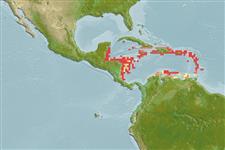Actinopterygii (ray-finned fishes) >
Perciformes (Perch-likes) >
Chaenopsidae (Pike-, tube- and flagblennies)
Etymology: Acanthemblemaria: Greek, akantha = thorn + Greek, emblema, -atos, anything that is nailed, knocked in; also anything with bass or high relief (Ref. 45335).
Environment / Climate / Range
Ecology
Marine; reef-associated. Subtropical, preferred ?; 20°N - 10°N, 90°W - 58°W (Ref. 56264)
Western Atlantic: southeastern Florida (USA), Bahamas, and Yucatan, Mexico to the Greater Antilles and Panama. Antilles and western Caribbean (Ref. 26938).
Size / Weight / Age
Maturity: Lm ? range ? - ? cm
Max length : 4.0 cm TL male/unsexed; (Ref. 7251)
Almost always found in holes of corals. Feed on amphipods and copepods (Ref. 5521). Main diet of benthic harpacticoid copepods (Ref. 94105). Oviparous (Ref. 56066). Eggs are attached to the walls of the parent's shelter and are brooded by the male parent (Ref. 56066).
Life cycle and mating behavior
Maturity | Reproduction | Spawning | Eggs | Fecundity | Larvae
Oviparous (Ref. 56066). Males guard the eggs until they hatch (Ref. 56065).
Robins, C.R. and G.C. Ray, 1986. A field guide to Atlantic coast fishes of North America. Houghton Mifflin Company, Boston, U.S.A. 354 p. (Ref. 7251)
IUCN Red List Status (Ref. 115185)
CITES (Ref. 94142)
Not Evaluated
Threat to humans
Harmless
Human uses
Aquarium: commercial
More information
Age/SizeGrowthLength-weightLength-lengthLength-frequenciesMorphometricsMorphologyLarvaeLarval dynamicsRecruitmentAbundance
ReferencesAquacultureAquaculture profileStrainsGeneticsAllele frequenciesHeritabilityDiseasesProcessingMass conversion
Tools
Special reports
Download XML
Internet sources
